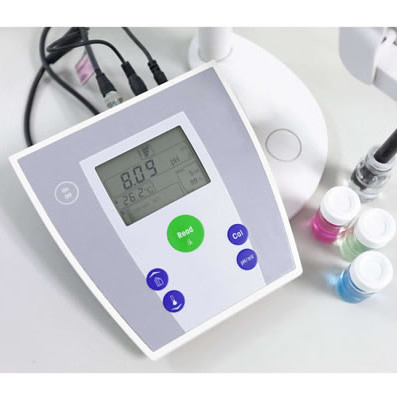Origin
The pH concept was discovered in 1909 in the Carlsberg Laboratory by a Danish chemist, Søren Sørenensen. A modern interpretation of this concept was developed in 1924 in an effort to adapt to novel electrochemical cells measurements.
Principle of pH
The pH indicator is based on the fact that molecules such as acids and bases in aqueous media disperse throughout the liquid and dissociate to expose their free hydronium [H3 O+] and hydroxide ions [OH–]. The concentration of [H3 O+] released is reflected in the solution’s pH value.1
As a logarithmic value, pH is calculated using the following equation, where [H3 O+] is concentration of ions (moles / liter or Molar):
pH = – log 10 [H3 O+]
This means that each unit increment of pH indicates a tenfold increment in [H 3 O+] and a scale of 0-14 is assigned to solutions of various strengths.
Extremely low pH 0.0 corresponds to extremely acidic solutions while a value of 14.0 corresponds to extremely alkaline solutions.Therefore, changing from pH 7 to 6 there is a tenfold increase in acidity. From 7 to 5 pH, the increase is 100-fold. And from 7 to 4, it is 1000-fold.2 Most bakery products pH ranges from 3.5 to 8.0.
The term pH should not be confused with the amount of acid (i.e. titratable acidity) of foods.
How it is measured
Using potentiometry principles, pH is determined by measuring the electric potential between glass and reference electrodes placed in an electrolytic cell. The developed voltage is a function of the ionic concentration of the solution.3
Approved methods for pH measurement include:
- AOAC 981.12 (pH meter – matrices: vegetables/acidified foods)
- AACC 02-52.01 (Electrometric method – matrices: flour and some bread, crackers, cakes, and pastry products)
Typical pH values of bakery products
| Product | pH |
| Baker’s yeast bread | 5.3-5.8 |
| Sourdough bread | 3.8-4.6 |
| Wafer sheets | 6.8-7.4 |
| Snack crackers | 5.5-5.6 |
| Soda crackers | 7.2-8.0 |
| Biscuits | 7.0-7.2 |
| Eggs | 6.6 |
| Honey | 3.7-4.2 |
| Milk (cow) | 6.4-6.8 |
Function
Many baking processes and overall baked products characteristics are directly related to the pH of the dough and/or the final products. Important functional aspects include:
- Physical state of the gluten: effect on viscosity build up and gluten degree of dissolution.
- Growth and activity of the yeast which impacts fermentation as well as amylolytic activity
- Preservation and microbial safety: Many pathogenic and spoilage microorganisms cannot survive in acidic environments. For example, bread rope caused by Bacillus spp. cannot grow at pH below 5.5.4
In baked goods, there are different ways to influence pH:
- By adding acids to the dough, such as fumaric, malic, citric or acetic. This is a very precise and practical method.
- Via fermentation (alcoholic and/or lactic), as in the case of sourdoughs and preferments. This process increases dough acidity (lowering pH) based on beneficial microbial growth.
Application
A pH of 5.1 to 5.4 is generally accepted as being conducive to the production of a desirable crumb in white bread. In sponge or liquid ferments, the final pH value should be between 4.5 and 5.1 to yield doughs with pH values between 5.0 and 5.2.
Prevailing pH in chemically-leavened baked goods is used as an indicator of the sodium bicarbonate neutralization efficiency. This is very important for the finished product quality as excess bicarbonate can increase the degree of browning caused by Maillard reactions which favor high pH values (>8.0). To prevent this, additional acid, e.g., cream of tartar (potassium bitartrate) is added to lower the pH and neutralize remaining baking soda.4
During fermentation (alcoholic and/or lactic), dough undergoes increased acidity (lower pH) which contributes to the shelf life, flavor, color, and rheological properties of the product.
In gluten-free baked products, pH control is of utmost importance especially for hydrocolloid functionality. A hydrocolloid molecule held at its isoelectric point is insoluble in water, which is essential obtaining optimal dough rheology and bread quality.5,6
References
- Cauvain, S.P. “Testing Methods.” Baking Problems Solved, 2nd ed., Woodhead Publishing Limited, 2017, pp. 469–470.
- Timberlake, K. “Acids and Bases.” Basic Chemistry, 5th ed., Pearson Education Limited, 2017, pp. 490–496.
- Nielsen, S.S. “Standard Solutions and Titratable Acidity.” Food Analysis Laboratory Manual, 3rd ed., Springer International Publishing, 2017, pp. 179–184.
- Cauvain, S.P. “Other Ingredients.” Baking Problems Solved, 2nd ed., Woodhead Publishing Limited, 2017, p. 109.
- Edwards, W.P. “Science.” The Science of Bakery Products, The Royal Society of Chemistry Publishing, 2007, p. 13.
- Cauvain, S. P. and Young, L. S. “Baking with Yeast” Technology of Breadmaking, 2nd.Ed. Springer International Publishing, 2007, pp. 84-86.

